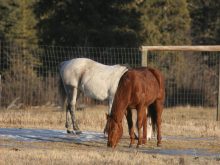Seizures are defined as changes in behaviour and consciousness that result from random, uncontrolled and abnormal electrical brain activity. This atypical electrical brain activity can be restricted to a specific area of the brain causing a focal seizure. If it affects most of the brain tissue, it causes a generalized seizure. Most familiar are the involuntary movement of muscles and unconsciousness that occur with some types of seizures.
The term epilepsy is used for individuals with recurrent seizures that don’t have a known cause. Dogs frequently get epileptic seizures and most are of the idiopathic type, meaning we don’t know the cause.
Read Also

Beef cattle more prone to trace mineral deficiencies
The trace mineral status of our cows and calves is a significant challenge for western Canadian producers and veterinarians.
Unlike dogs and people, seizures in horses are most often related to some type of underlying disease and only rarely arise spontaneously.
Horse seizures can manifest in various ways. Discrete signs include lip smacking, drooling, staring or blinking. Other horses have more classical-type seizures where the horse falls down and convulses. Muscles contract violently and involuntarily. The horses may also go stiff and extend their legs and neck.
Seizures in some cases can progress with time, becoming more frequent and severe. In other cases, the horse can “grow out” of seizures as they age.
One of the main issues with horses that have seizures is that they may harm themselves in the process. It can also be especially dangerous to handle affected horses since they can hurt the people around them. Another complication of seizures in horses is the inhalation of food material into their lungs. This can lead to aspiration pneumonia, a serious condition characterized by inflammation and infection of the lungs that is difficult to treat.
The root cause of seizures is sometimes distinct abnormalities in the brain tissue. These include accumulated material in cells and loss of the fatty myelin insulation between nerves.
In Egyptian Arabian horses, there is an inherited disease called juvenile idiopathic epilepsy. Foals of this breed that are less than one year of age develop recurrent spontaneous seizures. If the foals survive, they tend to grow out of them after reaching a year old. It is suspected that epilepsy in this particular type of Arabian horse is the result of a genetic defect, although scientists have not yet identified the exact gene.
Seizures are particularly common in young foals and can occur due to a variety of underlying causes. Brain infections from bacteria or viruses can trigger them. Trauma to the head is another potential cause. Foals that are sick, such as those with severe diarrhea or blood infections, may also develop electrolyte imbalances that can cause seizures.
If the mare has difficulty giving birth, the foal may have low brain oxygen levels, which is yet another way seizures can be stimulated. There are also seizures related to rare birth defects such as water-on-the-brain (hydrocephalus). In general, foals that have seizures are less likely to survive compared to those without them.
Treatment of seizures in horses involves identifying and addressing the underlying cause if one exists. This can involve treating an infection or correcting abnormal electrolytes, for instance. There are medications that can stop or reduce the frequency of seizures. Supportive care may include fluids and protection from self-trauma with the use of fearsome-looking specialized horse helmets and padded stalls.
The non-typical seizure behaviours such as lip smacking, drooling, staring or excessive blinking are worth investigating as potentially caused by a seizure, although other causes of these abnormal behaviours need to be ruled out.
Most of us may never see a horse have a seizure, but it is useful to recognize that it can occur in this species.
Dr. Jamie Rothenburger, DVM, MVetSc,PhD, DACVP, is a veterinarian who practices pathology and is an assistant professor at the University of Calgary’s Faculty of Veterinary Medicine. Twitter: @JRothenburger















